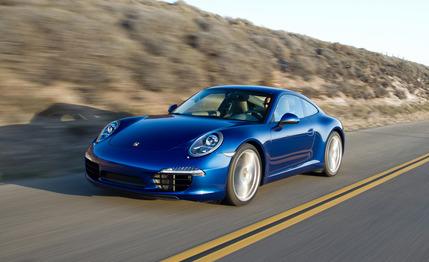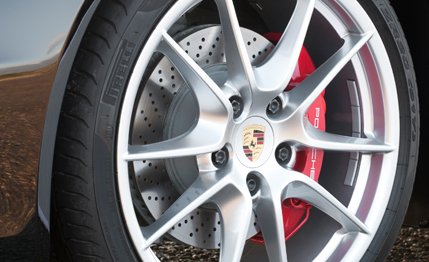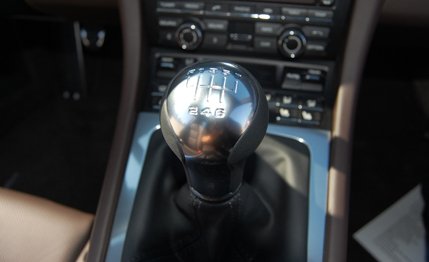 First Drive Review
First Drive Review
Longer, lower, wider, faster, more fuel efficient, and—amazingly—slightly lighter, according to the company, the new Porsche 911 Carrera is a better car in every way. Which means it’s less like a Porsche 911 than ever, because let’s face it, much of what made the model an icon have been its eccentricities.
Up until the late 1990s, mastering a 911 was lion tamer’s work. The 996 and 997 generations greatly improved drivability, and the lion has been thoroughly tamed with the 2012 redesign. Anybody who draws breath and has the dough (China is rapidly filling up with candidates) can safely cuddle up with this cushy kitty. The wheelbase is stretched, the front track is wider, and the rear-biased weight split is claimed to be closer to equalization—all of which promotes on-road stability and reduces the midcorner bounding and corner-exit steering washout that make older 911s so, er, thrilling. The electronic suspension devices and the traction-control systems are more capable, making the steering response even snappier and the car more eager to go where you point it.
Carrer-amera?
Granted, the only version provided for our drive was a 3.8-liter Carrera S with the optional Sport Chrono package. So equipped, it includes Porsche’s dynamic engine mounts, which we’ve often praised for helping settle the car down over pitching pavement. All comments should thus be so flagged. But whatever version you drive, the car feels big. When did the 911 get to be the same length as an Audi A6? It’s not actually that large, but it seems it. Dare we call it the Carrer-amera?

Yes, we dare. The influence of the Panamera is obvious once you crack open the doors and see that long ski slope of a center console studded with buttons. Porsches used to have nothing but a shifter and air between the seats, which emphasized the fact that the oily bits were out back. Porsche design director Michael Mauer says the 911 is the source for all Porsche brand styling, but in this case, it looks as though the company’s big, front-engined limo—and strategic cost-saving component sharing—had a say.
By the way, for decades Porsche has given all its projects an internal number starting with “9,” and it’s now running out of numbers. We were told at the lavish international launch in Santa Barbara, California—where a blue-sky budget included grinding and resurfacing an old weather-beaten airport apron to serve as an autocross course—that the new 911’s 991 project code was selected simply because it was still available. In the future, Porsche plans to start mixing in letters to get codes like 9A1, the designation for the new family of direct-injection boxer engines.
Haven’t We Seen You Before? Of Course We Have
Meanwhile, the rest of the new Carrera looks every inch a 911, if for no other reason than customers expect it to be so. The differences live in the details: the roof and the front fender humps—the latter capped by domed headlamps—are lower and give the car a wider, more-limpet-like road stance. The red-dagger taillamps live under a furrowed brow running around the back; Mauer says this look eventually will migrate to all Porsches.

Using the driver’s hip point as a reference for the change in wheelbase, the front axle moves forward by 1.2 inches, and the rear moves aft by just under three. The overhangs have been reduced, so the body is 2.2 inches longer overall. The windshield center point moves about three inches forward, but the glass has more curve to it and wraps around to A-pillars that have moved hardly at all.
Nothing carries over from the 997’s body shell, which employed far less aluminum in its construction. In contrast, the lighter material comprises about 45 percent of the new car’s shell, including the floor, roof, doors, and all structural and exterior sheetmetal forward of the windshield. Steel is limited mainly to the piece that forms the rear quarter-panels and door frames. It is a complex single part that requires seven separate stampings and that Porsche’s stamping supplier said was too deeply curved to form from aluminum. We’re estimating curb weights will be about 3250 pounds for the Carrera and 3350 for Carrera S, or basically the same as before. (For its part, Porsche says the S weighs about 10 fewer pounds.)
This is the enviro 911, the press kit for which touts not the new power figures (350 hp for the Carrera and 400 hp for the S, increases of 5 and 15) but the potential fuel saving from each engine technology. An idle stop/start system that buyers can disable if they want saves up to 1.5 mpg, for example. An alternator that charges at a higher rate on deceleration: 0.4 mpg. A coast-down function that, in cars equipped with the PDK twin-clutch gearbox, automatically decouples the engine in some deceleration scenarios and lets it drop to idle could save a maximum of 2.5 mpg. The final EPA window-sticker numbers won’t be released until early December, but city and highway mileage will probably rise 1 to 2 mpg for the Carrera and Carrera S depending on the transmission.